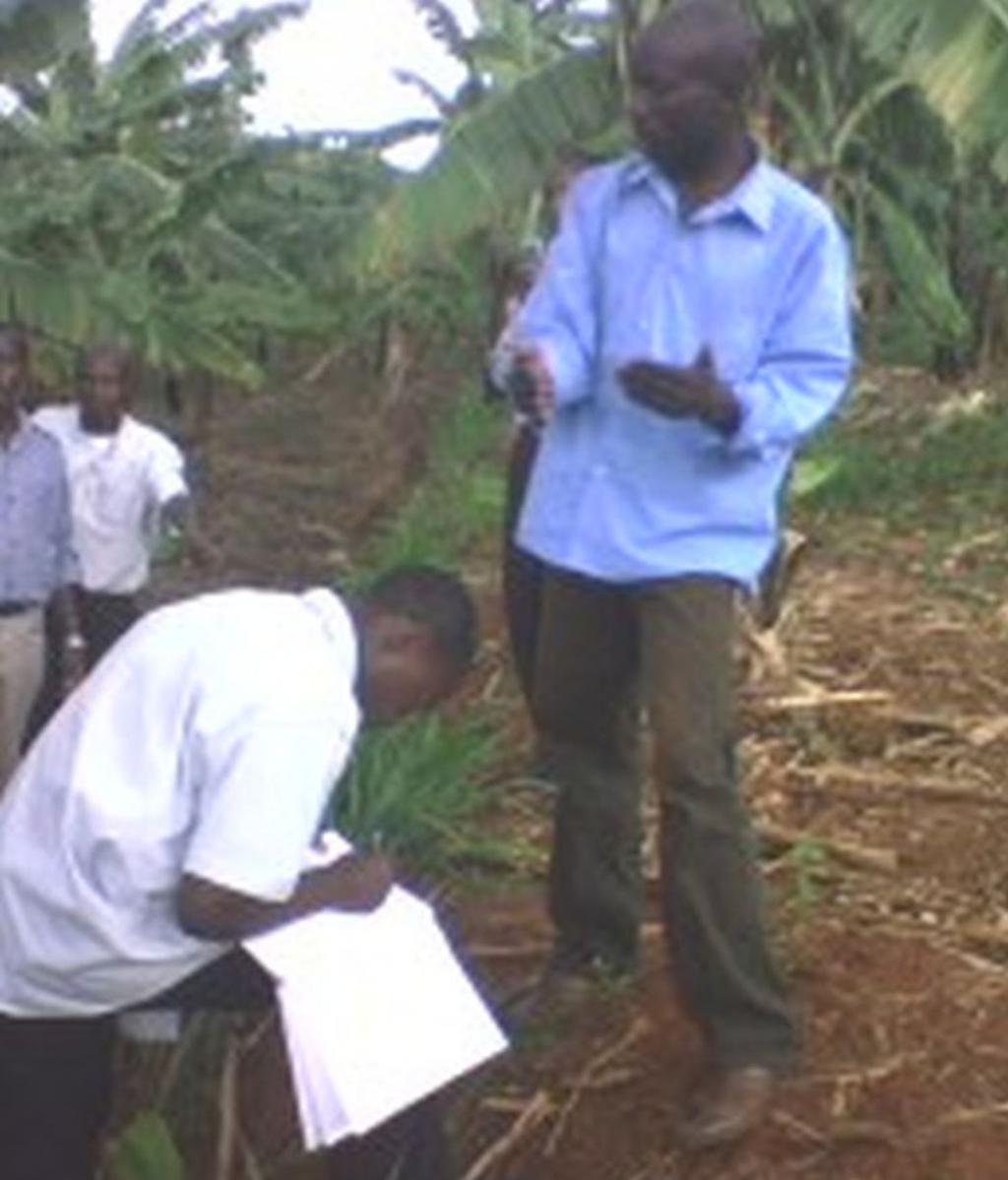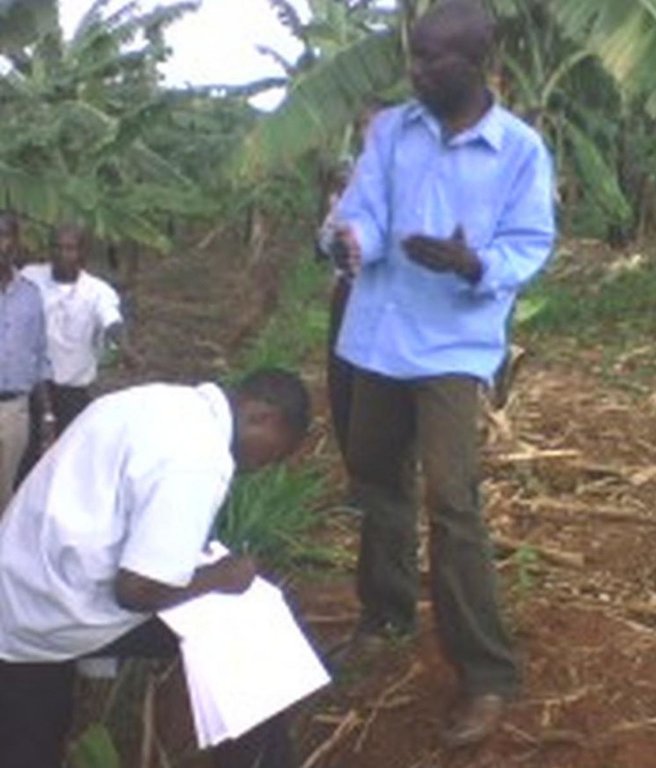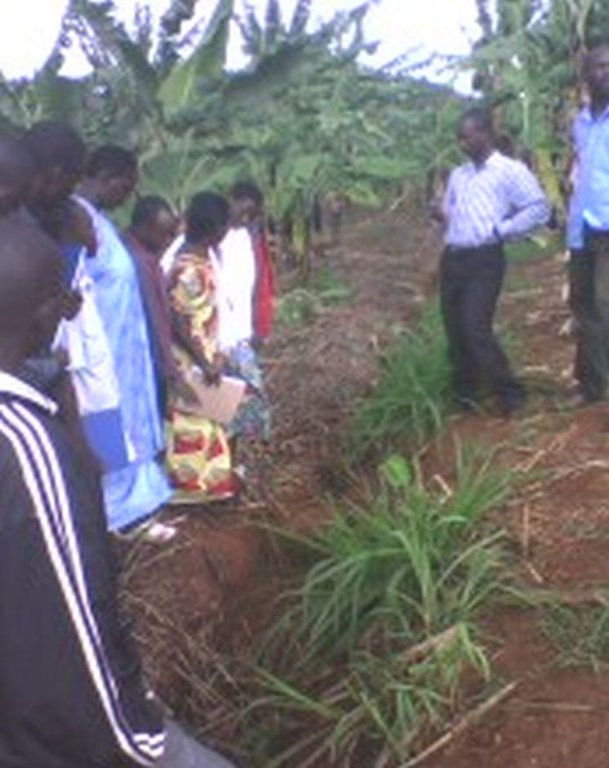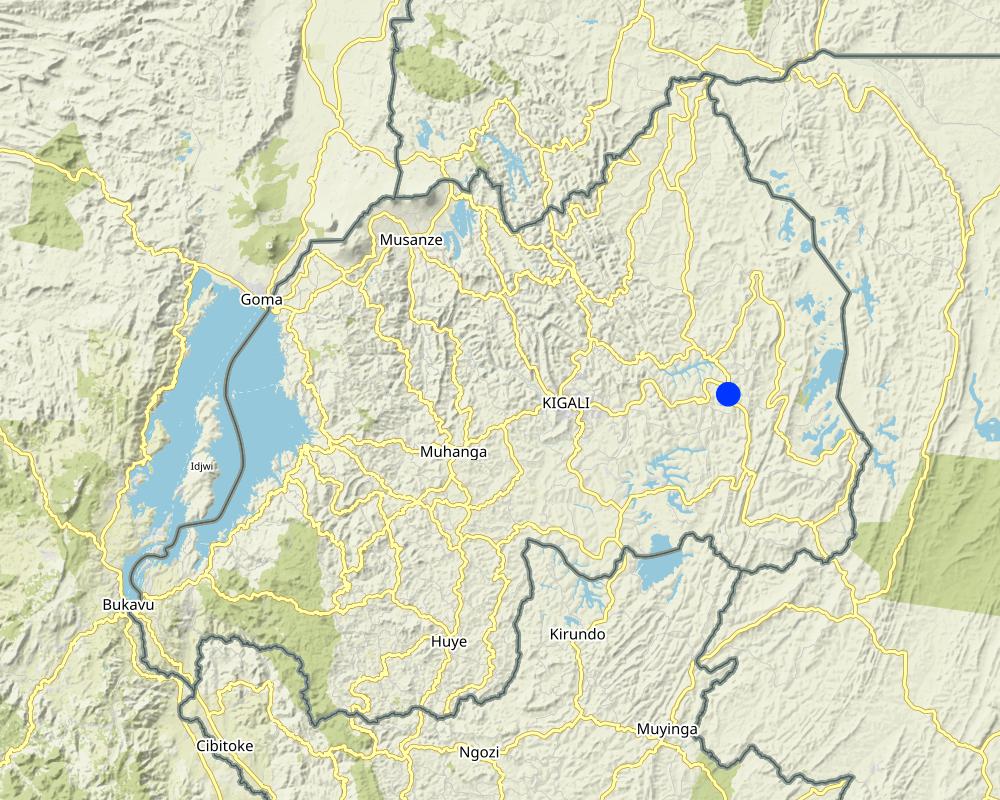Spontaneous farmer to farmer adoption [卢旺达]
- 创建:
- 更新:
- 编制者: Desire Kagabo
- 编辑者: –
- 审查者: David Streiff, Joana Eichenberger
Kwigira ku bandi
approaches_2585 - 卢旺达
查看章节
全部展开 全部收起1. 一般信息
1.2 参与方法评估和文件编制的资源人员和机构的联系方式
SLM专业人员:
有助于对方法进行记录/评估的项目名称(如相关)
The Transboundary Agro-ecosystem Management Project for the Kagera River Basin (GEF-FAO / Kagera TAMP )有助于对方法进行记录/评估的机构名称(如相关)
Rwanda Agriculture Board (Rwanda Agriculture Board) - 卢旺达有助于对方法进行记录/评估的机构名称(如相关)
FAO Food and Agriculture Organization (FAO Food and Agriculture Organization) - 意大利1.3 关于使用通过WOCAT记录的数据的条件
编制者和关键资源人员接受有关使用通过WOCAT记录数据的条件。:
是
2. SLM方法的描述
2.1 该方法的简要说明
Diffusion of sustainable land management technologies through an effective farmer-to-farmer diffusion approach
2.2 该方法的详细说明
该方法的详细说明:
Aims / objectives: Knowledge sharing through observation and experiments of self motivated individual farmers. The spillover of a technology/practice among farmers is simply motivated by good yield and other production factors of the technologies.
Methods: Farmer to farmer learning and adoption of new products/technology
Stages of implementation: Existing of best and new technologies, curiosity of farmers about the new product, experiment of the new products and adoption.
2.3 该方法的照片
2.5 采用该方法的国家/地区/地点
国家:
卢旺达
区域/州/省:
East
有关地点的进一步说明:
Kirehe
注释:
The area is approximately well known
Map
×2.6 该方法的开始和终止日期
注明开始年份:
1940
2.7 方法的类型
- 传统/本土
2.8 该方法的主要目的/目标
The Approach focused mainly on SLM with other activities (maintenance of soil moisture and soil fertility)
Learning from others' experiences.
The SLM Approach addressed the following problems: Low productivity of lands due to poor management of soil and low/none use of agricultural inputs. In addition, the problem is aggravated by inadequate soil erosion control measures.
2.9 推动或妨碍实施本办法所适用的技术的条件
财务资源和服务的可用性/可得性
- 阻碍
Lack of resources especially for soil erosion technologies that require heavy investments and mobilization of all stakeholders
Treatment through the SLM Approach: Government support is required.
法律框架(土地使用权、土地和水使用权)
- 启动
- 阻碍
了解SLM,获得技术支持
- 阻碍
Soil fertility decline and soil degradation due to a lack of knowledge and resource in soil fertility management and on a better agriculture practice in banana field.
Treatment through the SLM Approach: Creation of Innovation Platforms, watershed management committees, etc.
3. 相关利益相关者的参与和角色
3.1 该方法涉及的利益相关者及其职责
- 当地土地使用者/当地社区
Innovative land users make a promotion of a technology and other farmers learn from them.
Farmers explains each other about a technology
3.2 当地土地使用者/当地社区参与该方法的不同阶段
| 当地土地使用者/当地社区的参与 | 指定参与人员并描述活动 | |
|---|---|---|
| 启动/动机 | 自我动员 | Individual farmers by simple observation of what is happening in the neighborhood. |
| 计划 | 自我动员 | Individual initiative and this starts by curiosity and awareness. A self motivated farmer approaches the owner of promising agricultural technologies/practices for more details. |
| 实施 | 自我动员 | There is no formal model |
| 监测/评估 | 自我动员 | |
| Research | 被动 |
3.4 有关SLM技术选择的决策
具体说明谁有权决定选择要实施的技术:
- 仅限土地使用者(自主)
解释:
Innovative land users make a promotion of a technology and other farmers learn from them.
Decisions on the method of implementing the SLM Technology were made by by land users* alone (self-initiative / bottom-up)
4. 技术支持、能力建设和知识管理
4.1 能力建设/培训
是否为土地使用者/其他利益相关者提供培训?:
是
明确受训人员:
- 土地使用者
培训形式:
- 农民对农民
- 示范区域
涵盖的主题:
soil moisture conservation and soil fertility improvement
4.2 咨询服务
土地使用者有权使用咨询服务吗?:
是
指明是否提供了咨询服务:
- 在土地使用者的土地上
说明/注释:
Name of method used for advisory service: Extension; Key elements: farmer to farmer exchange visit
Advisory service is very adequate to ensure the continuation of land conservation activities; the impact of the technology on production is very high.
4.3 机构强化(组织发展)
是否通过这种方法建立或加强了机构?:
- 否
4.4 监测和评估
监测和评估是该方法的一部分吗?:
是
注释:
Economic / production aspects were ad hoc monitored by land users through observations; indicators: Farmers observed that the yield increases due to the technology
Area treated aspects were ad hoc monitored by government through observations
No. of land users involved aspects were ad hoc monitored by land users through measurements
There were no changes in the Approach as a result of monitoring and evaluation
There were no changes in the Technology as a result of monitoring and evaluation
4.5 研究
研究是该方法的一部分吗?
否
5. 融资和外部物质支持
5.1 该方法中SLM组成部分的年度预算
如果不知道准确的年度预算,请给出一个范围:
- < 2,000
注释(例如主要的资助来源/主要捐助者):
Approach costs were met by the following donors: local community / land user(s) (land users): 90.0%; other (governmental SLM specialist): 10.0%
5.2 为土地使用者提供财政/物质支援
土地使用者是否获得实施该技术的财政/物质支持?:
否
5.3 对特定投入的补贴(包括劳动力)
- 无
如果土地使用者的劳动力是一项重要的投入,那么是不是:
- 自愿
5.4 信用
是否根据SLM活动的方法给予信用值?:
否
6. 影响分析和结论性陈述
6.1 方法的影响
该方法是否帮助土地使用者实施和维护SLM技术?:
- 否
- 是,很少
- 是,中等
- 是,支持力度很大
Most of farmlands in the area and its surrounding have adopted the technology which highly reduced the soil erosion hence the increase of crop yield (probably due to the increasing of soil organic matter content).
Did the Approach lead to improved livelihoods / human well-being?
- 否
- 是,很少
- 是,中等
- 是,支持力度很大
The approach helped to rapidly adopt the technology which in return improved the crop yield. Due to the efficiency of mulching in reducing soil erosion , the sustainability of land management has improved as a result.
Did the Approach help to alleviate poverty?
- 否
- 是,很少
- 是,中等
- 是,支持力度很大
In the region, banana crop is a staple crop. However, due to access of new markets in cities, banana is now regarded as a cash crop hence contributing to the increase of farm income.
6.3 方法活动的可持续性
土地使用者能否维持通过该方法实施的措施(无外部支持的情况下)?:
- 是
若是,请说明如何维持:
Yes because farmers explain by their own to other farmers which facilitate the spreading of any technology quickly
6.4 该方法的长处/优点
| 土地使用者眼中的长处/优势/机会 |
|---|
| This approach can carry messages and content on other subjects than S.L.M. only (How to sustain/ enhance this strength: promote the approach as a general grassroots-based extension approach) |
| 编制者或其他关键资源人员认为的长处/优势/机会 |
|---|
| Both the service provider and the demand groups are local farmers; this approach therefore directly benefits only the local farming community (How to sustain/ enhance this strength: sensitization ) |
| Technologies adopted through farmer-to-farmer diffusion are likely to be more stable and sustainable because innovative farmers will only disseminate successful technologies (How to sustain/ enhance this strength: sensitization ) |
6.5 该方法的弱点/缺点以及克服它们的方法
| 编制者或其他关键资源人员认为的弱点/缺点/风险 | 如何克服它们? |
|---|---|
| some farmers are resilient to help other | sensitization and involvement of those resilient farmers in local decision making. |
7. 参考和链接
7.1 方法/信息来源
- 实地考察、实地调查
- 与土地使用者的访谈
链接和模块
全部展开 全部收起链接
无链接
模块
无模块





